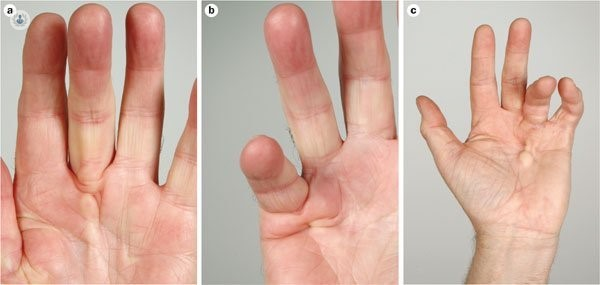Symptoms and causes of Dupytren's contracture
Written in association with:What is Dupuytren's Contracture?
Dupuytren's contracture is a chronic condition of the hand that progressively causes one or more fingers to become bent in a permanent position (usually the ring finger followed by the little finger, heart and index fingers), restricting function in the hand.
Dupuytren’s contracture mostly affects white people, more commonly males over the age of 50. In women, it appears at a more advanced age, the condition is less intense. In general, the contracture affects both hands, although it usually manifests first in one, especially in the right.
The condition is named so because of the surgeon, Guillaume Dupuytren, who first described the signs of the disease in the XIX century.
Learn more about "the Viking disease"!
Causes of Dupuytren's contracture
Dupuytren's contracture is caused by the thickening and retraction of the membrane that forms the sheath of the flexor tendons of the fingers (palmar aponeurosis). Unlike trigger finger, this condition does not affect the tendons but the fascia (a layer of tissue that lies under the skin), but it does impede the normal mobility of the tendons.
There is no apparent cause, but it appears more frequently in people who perform certain manual tasks that require vibrating tools (pneumatic drills, etc.). Diabetes, antiepileptic drug use, smoking and alcoholism may also cause development of the condition.
There is also a genetic predisposition to Dupuytren's contracture, as it affects 50% of the members of the same family in those that have the condition.
Symptoms of Dupuytren's contracture
In Dupuytren's contracture, tissues that lie beneath the skin thicken and retract, resulting in the formation of small, hard fibrous, palpable balls (nodules) in the palm of the hand.
Subsequently, a kind of cord formed by thickened tissue (retraction flange) appears under the skin. Later, the joints of the fingers are affected by flexion.
The onset of the disease is usually painless. It can remain so for years, during which time the finger movements remain free but are slightly diminished. Later, hand mobility begins to worsen, especially when grasping objects, and there may be great difficulty in fully supporting the palm of the hand on a flat surface or fully stretching the fingers. In some cases, the fingers cannot be separated (splayed).
At a more advanced stage, the fingers become locked, and cannot be extended.
Patients experience difficulties in the normal course of their work and they have trouble putting on their shoes, shaking hands, combing, washing, applying makeup etc.
In the presence of one or more of the above symptoms, and especially if the patient has some of the predisposing causes, it is advisable to consult a doctor as soon as possible. The recovery is much more favourable the earlier the condition is discovered and treated.
Stages of Dupuytren's contracture

• First stage: the patient feels thickening in the skin of the palm of the hand, in which new depressions appear. Bumps appear on the fingers, near the knuckles (Garrod's nodes) and knuckle pads are formed.
• Middle stage: The patient may feel firm, raised bumps and lumps under the skin of the palm of the hand or fingers. There may also be a rope of firm, thickened tissue in the hand or fingers.
• Advanced stage: one or more of the fingers bend towards the palm of the hand.
Treatment of Dupuytren's contracture
Treatment for Dupuytren's contracture, which has greatly evolved over the past 10 years, aims to recover the function of extension in the fingers without loss of flexion. It is usually effective in more than 80% of cases, although if there is blockage of the joint, it is not quite as effective (70%).
Percutaneous surgery usually yields good results if Dupuytren's contracture is treated in its early stages.
Surgery for Dupytren’s contracture
Fasciotomy: a special needle or blade divides the strings in the palm of the hand or finger.
Fasciectomy: some or all of the thickened tissue and strings are removed.
Joint surgery: releases the joint.
After surgery, rehabilitation treatment is recommended to reduce the symptoms, and to help the hand to function better. A physiotherapy specialist will help with hand exercises that aim to increase the mobility of the hand and fingers.
Sometimes in those with Dupuytren's contracture, thickened lumps of tissue may appear on other parts of the body. For example, if it appears on the feet, it could be plantar fibromatosis or Ledderhose disease. In men, bulges can form in the penis, in what is known as penile fibromatosis or Peyronie's disease. However, Dupuytren's palmar fibrosis and its impact on the hand is the most limiting of all these conditions
Advantages of minimally invasive surgery
Minimally invasive surgery allows both early and late treatment of Dupuytren's contracture, which offers great advantages over conventional open surgery:
• There is less damage to the skin and, therefore, the fibrous scars are smaller
• The risk of vascular injury and skin necrosis is minimal
• There is less aesthetic damage.
• Recovery is much faster
• Return to work is faster, and sports activities can be commenced sooner
• If further surgery is necessary, it is easier to perform, since extensive scarring is not likely happen
• The likelihood of relapse seems to be the same as with classical open surgery procedures
With all these considerations in mind, minimally invasive surgery is usually the most recommended option.


